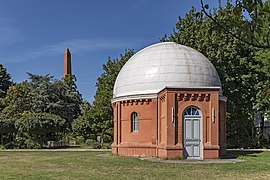Toulouse Observatory
 Facade of the main building | |
| Observatory code | 004 |
|---|---|
| Location | Toulouse, France |
| Coordinates | 43°36′44″N 1°27′46″E / 43.61233°N 1.46278°E |
| Established | 1733, 1841, 1981 |
| | |
The Toulouse Observatory (French: Observatoire de Toulouse) is located in Toulouse, France and was established in 1733.[1]
It was founded by l'Académie des Sciences, Inscriptions et Belles-Lettres de Toulouse ("Academy of Science, Inscriptions and the Humanities of Toulouse"). It was moved 1841 and again in 1981.[citation needed]
In 1987, Genevieve Soucail of the Toulouse Observatory and her collaborators presented data of a blue ring-like structure in Abell 370 and proposed a gravitational lensing interpretation[2]
In the 1990s the observatory worked on MEGACAM with several other institutions.[3]
People & Directors[edit]
The observatory was started by Garipuy in the 1730s with support from the Academy of Sciences.[4]
Félix Tisserand was a famous director from 1873 to 1878. He published Recueil d'exercices sur le calcul infinitesimal as well as making several expeditions, including an 1874 trip to Japan. Henri Joseph Anastase Perrotin was Tisserand's assistant astronomer, and they both went to the Paris Observatory in 1878. Tisserand was succeeded by Benjamin Baillaud.
| Director | Life span | Years of directorship |
|---|---|---|
| Frédéric Petit | 1810–1865 | 1838–1865 |
| Théodore Despeyrous | 1815–1883 | 1865–1866 |
| Pierre Daguin | 1814–1884 | 1866–1870 |
| Félix Tisserand | 1845–1896 | 1873–1878 |
| Benjamin Baillaud | 1848–1934 | 1878–1907 |
| Eugène Cosserat | 1866–1931 | 1908–1931 |
| Emile Paloque | 1891–1982 | 1931–1960 |
| Roger Bouigues | 1920– | 1961–1971 |
| Jean Rösch | 1915–1999 | 1971–1981 |
History & Telescopes[edit]

The observatory was originally founded in 1733.[5] Launch instruments at the observatory included two refractors and 28 inch quadrant, and one clock.[6][4] By 1840 and additional clock by Julien le Roi of Paris was added.[6]
Among the early observations at the observatory were the 1736 and 1743 transits of Mercury.[4] These observations were conducted by Garipuy, who also observed the transit of Mercury in 1753.[4] Garipuy also built and observatory in his house and conducted observations from there.[4]
By 1770 a new larger observatory was established and again in the 1840s.[7]
In 1871-1873 Toulouse observatory switched from being a municipal to provincial observatory.[8]
In 1873 a 4.5 inch (10.8 cm) refractor by Secretan was added to the Observatory.[9]
In 1875 a reflecting telescope by Henry Brothers was added.[10][11] The 83 centimetres (33 in) diameter aperture was a reflecting telescope (i.e. mirror) mounted on an equatorial.[10] In 1880 the reflector was re mounted on a cast iron design by Gautier, replacing the wood mounting.[8]
Also in 1880 a new refractor (lens) was acquired, a 9 inch (22 cm) aperture by Brunner.[8] Several other instruments were added at this time, and in the early 1900s a new telescope for the Pic Du Midi mountaintop observatory was also added.[8]
In the 1880s Toulouse Observatory sent some of its oldest instruments to a museum.[12] This included a transit instrument by Lennel dating to 1774, Dollond telescope, and several quadrants.[12]
The observatory participated in the Carte Du Ciel project, recording over a thousand plates (i.e. astronomical photographs) between 1887 and 1939.[8]
In the 1980s astronomers of Toulouse Observatory discovered a gravitational lens in space.[13] They found an arc around Abel 370 and were able to recognized it as this phenomenon.[13]
Facilities[edit]
The observatory has used many telescopes over its lifetime.[10] For example, an 83 cm aperture reflecting telescope was installed in 1875.[11]
-
The eastern façade of the Urbain Vitry building
-
Urbain Vitry cupola
-
Cupola of the 83 cm telescope
See also[edit]
- List of astronomical observatories
- Pic du Midi Observatory
- Observatoire Midi-Pyrénées
- List of largest optical telescopes of the 19th century
References[edit]
- ^ MSN Encarta "Toulouse" Archived 2009-04-11 at the Wayback Machine "Toulouse," Microsoft Encarta Online Encyclopedia 2008 http://encarta.msn.com©1997–2008 Microsoft Corporation. All Rights Reserved. Archived 1999-10-12 at the Wayback Machine
- ^ Soucail, G.; Mellier, Y.; Fort, B.; Mathez, G.; Hammer, F. (October 1987). "Further data on the blue ring-like structure in A 370". Astronomy and Astrophysics. 184 (1–2): L7–L9. Bibcode:1987A&A...184L...7S. ISSN 0004-6361.
- ^ "MEGACAM: A Status Report Derrick Salmon, CFHT". Archived from the original on 2009-09-18. Retrieved 2009-03-01.
- ^ a b c d e Tisserand, F. (1881). "1881AReg...19..218T Page 218". Astronomical Register. 19: 218. Bibcode:1881AReg...19..218T. Retrieved 2019-11-14.
- ^ The City of Toulouse. Ambassade de France, Service de Presse et d'Information. 1971.
- ^ a b Faidit, Jean-Michel (1994). "1994JHA....25..199F Page 199". Journal for the History of Astronomy. 25: 199. Bibcode:1994JHA....25..199F. doi:10.1177/002182869402500303. S2CID 116440552. Retrieved 2019-11-14.
- ^ The Athenaeum. J. Lection. 1891.
- ^ a b c d e Hutchins, Roger (2008). British University Observatories, 1772-1939. Ashgate Publishing, Ltd. ISBN 9780754632504.
- ^ Hutchins, Roger (2008). British University Observatories, 1772-1939. Ashgate Publishing, Ltd. ISBN 9780754632504.
- ^ a b c Lukac, Marie R.; Miller, R. J. (2000). List of Active Professional Observatories. U.S. Naval Observatory.
- ^ a b Lequeux, James (2013-03-15). Le Verrier—Magnificent and Detestable Astronomer. Springer Science & Business Media. ISBN 9781461455653.
- ^ a b The Observatory. Editors of the Observatory. 1884. p. 235.
- ^ a b Brunier, Serge (1999-10-28). Majestic Universe: Views from Here to Infinity. Cambridge University Press. ISBN 9780521663076.
External links[edit]
- Official Website
- History
- [1]
- Publications of Toulouse Observatory on Paris Observatory digital library
Further reading[edit]
- Levy, Jacques R. (1970–1980). "Bigourdan, Camille Guillaume". Dictionary of Scientific Biography. Vol. 2. New York: Charles Scribner's Sons. pp. 126–127. ISBN 978-0-684-10114-9.




